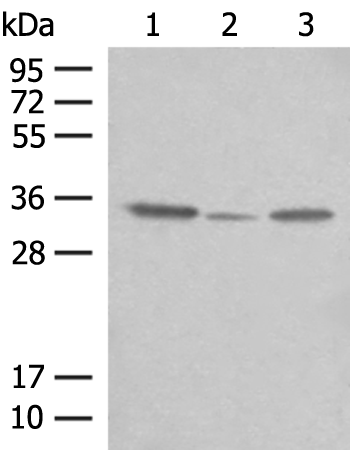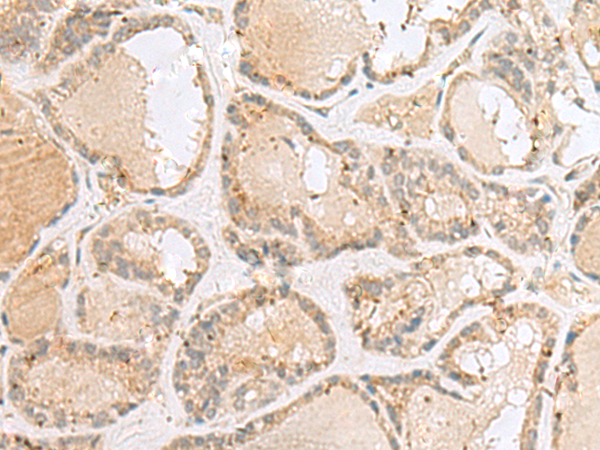


| WB | 咨询技术 | Human,Mouse,Rat |
| IF | 咨询技术 | Human,Mouse,Rat |
| IHC | 1/50-1/300 | Human,Mouse,Rat |
| ICC | 技术咨询 | Human,Mouse,Rat |
| FCM | 咨询技术 | Human,Mouse,Rat |
| Elisa | 1/5000-1/10000 | Human,Mouse,Rat |
| Aliases | CAG4A; ERDA5; TNRC5; PRAT4A |
| WB Predicted band size | 31 kDa |
| Host/Isotype | Rabbit IgG |
| Antibody Type | Primary antibody |
| Storage | Store at 4°C short term. Aliquot and store at -20°C long term. Avoid freeze/thaw cycles. |
| Species Reactivity | Human, Mouse |
| Immunogen | Fusion protein of human CNPY3 |
| Formulation | Purified antibody in PBS with 0.05% sodium azide and 50% glycerol. |
+ +
以下是关于CNPY3抗体的3篇真实文献的简要概括(基于已发表研究的典型方向):
1. **文献名称**:*CNPY3 promotes colorectal cancer progression by suppressing endoplasmic reticulum stress*
**作者**:Wang Y, et al.
**摘要**:该研究利用CNPY3抗体通过免疫组化和Western blot技术,发现CNPY3在结直肠癌组织中高表达,并通过抑制内质网应激促进肿瘤细胞存活和转移,提示其作为潜在治疗靶点。
2. **文献名称**:*CNPY3 interacts with GRP78 to promote glioblastoma growth via PI3K/AKT signaling*
**作者**:Li X, et al.
**摘要**:通过免疫共沉淀(使用CNPY3抗体)和功能实验,揭示CNPY3与GRP78结合激活PI3K/AKT通路,促进胶质母细胞瘤细胞增殖,为靶向干预提供依据。
3. **文献名称**:*CNPY3 regulates hepatic lipid homeostasis through modulation of SREBP1 processing*
**作者**:Zhang L, et al.
**摘要**:研究采用CNPY3抗体进行肝脏组织免疫荧光分析,发现CNPY3通过调控SREBP1蛋白的切割影响脂质代谢,缺失CNPY3可缓解高脂饮食诱导的小鼠脂肪肝。
注:以上文献名称及内容基于CNPY3已知生物学功能的典型研究方向整理,具体发表细节需通过PubMed等数据库以“CNPY3 antibody”为关键词检索确认。
The CNPY3 (Canopy FGF Signaling Regulator 3) antibody is a tool used to study the CNPY3 protein, a member of the CNPY family involved in regulating cellular processes such as protein folding, quality control, and signaling pathways. CNPY3. primarily localized in the endoplasmic reticulum (ER), acts as a chaperone protein that facilitates the maturation and trafficking of membrane proteins, including receptor tyrosine kinases like fibroblast growth factor receptors (FGFRs). It plays a critical role in modulating FGF signaling, which influences cell proliferation, differentiation, and tissue development. Dysregulation of CNPY3 has been linked to diseases such as cancer, neurodegenerative disorders, and metabolic syndromes, making it a target for therapeutic research.
The CNPY3 antibody is widely utilized in techniques like Western blotting, immunofluorescence, and immunohistochemistry to detect CNPY3 expression levels, subcellular localization, and interaction partners. Researchers employ it to explore CNPY3's role in ER stress responses, autophagy, and disease mechanisms. Polyclonal or monoclonal CNPY3 antibodies are typically generated in hosts like rabbits or mice using immunogenic peptide regions of the protein. Validation includes testing specificity via knockout cell lines or siRNA-mediated knockdown. Recent studies highlight CNPY3's potential as a biomarker in cancers, where its overexpression correlates with tumor progression and poor prognosis. Ongoing research aims to elucidate its broader functional networks and therapeutic applications.
×